Archive for March, 2022
Cars with the Biggest Mileage

Irving Gordon in his 1966 Volvo 1800S.
There is such a thing as the “Million-Mile Club”, a club for owners of cars which have travelled the 1–million milestone. It is a very distinguished club that boasts a special list of cars and some special owners who have clicked over the huge distances. The details of the car plus its owner can be proudly enlisted for the world to see and admire. What cars feature most in the highest of highest mileage cub? Maybe not so surprising to some people, but a few of the older vehicles made by Volvo and Mercedes have made it onto this rather prestigious list. There certainly was a time where Mercedes Benz and Volvo made some of the most bulletproof cars on the planet.
Maybe some of these big mileage cars should be regarded as being sustainably green. How many times would other people have bought a new car in that time?
Now I have a sneaky suspicion that there could be an old Ford Falcon or a Commie that could make its way onto the big milage hall of fame. I did see on a Ford Forum page that of the AU-BF Falcon models, there was an AU Falcon Taxi with 930,000 km, and 04 BA Falcon XT wagon Egas with 906,600 km, an AU Forte Duel Fuel with 850,000 km and a BA Falcon Egas with 566,000 km on it. These are big numbers, but not quite 1 million miles! Sorry Holden fans, I can’t find any with much over 300,000 km!
Here’s a quick list of some of the furthest travelled cars on the planet – highest first:
- Over 3,000,000 miles (Over 4,800,000 km) – the highest recorded thus far by Irving Gordon in his 1966 Volvo 1800S. He changed the oil every 3,000 – 3,500 miles and changed the transmission fluid every 25,000 miles. Sadly, Irving has recently passed away.

Irving Gordon in his 1966 Volvo 1800S.
2) Gregorios Sachinidis with his 1976 Mercedes 240D clocked 2,850,000 miles. The car, predominantly a taxi, is now on display in Mercedes-Benz’s personal museum as the longest running vehicle in the brand’s history.
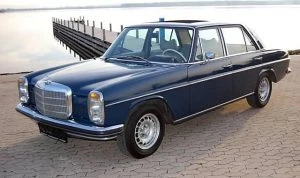
A Mercedes Benz 240D a bit like his.
3) 1979 Volvo 245 GL, a well maintained Finnish company vehicle covered 1,630,000 miles.

The Volvo 245 GL Estate
4) A 1963 Plymouth Fury takes out fourth place having reached 1,620,000 miles by 1999. It was owned and driven by Joseph Vaillancourt, however it was totalled by another road user in a truck running a red light. Thankfully Joseph was unhurt!

A Plymouth Fury
5) A 1983 Lincoln Town Car that was owned by Chet Belisle covered 1.3 million miles. He drove because he loved driving it.
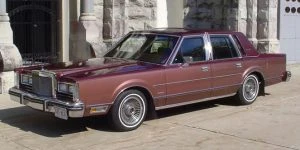
A Lincoln Town Car
6) A 1991 Chevrolet Silverado owned by Frank Oresnik put over 1.25 million miles on the odometer.
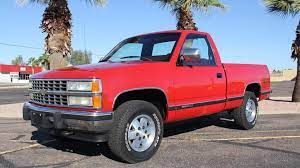
A 1991 Chevrolet Silverado
7) A 1993 Toyota Corolla in New Zealand has just recently clocked a huge 1.25 million miles (2,000,000 km) since new. The Whanganui Chronicle’s local newspaper delivery contractor, Graeme Hebley, bought the Corolla wagon from Japan in 2000 with 80,000 km on the odometer. Since then, he has since driven approximately 5000 km every week between Wellington and New Plymouth for work. The engine, transmission, bodywork, and drivetrain are entirely original, all thanks to a maintenance routine where the vehicle is serviced every second week. It has had its cambelt changed close to 20 times in its life.

Graeme Hebley and his Toyota Corolla
8) A 2006 Chevrolet Silverado 3500 Diesel owned by Hugh & Tammy Pennington has done well over the 1 million mile mark with no major maintenance. Routine servicing was the key.
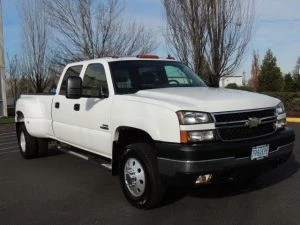
A 2006 Chevrolet Silverado
Fuel Prices: New Car?
It’s unfortunate to see that the prices for fuel in Australia have been on the steady increase across. Retailers suggest that the increase in the cost of fuel has come about through record oil prices and new logistical challenges for acquiring the fuel. It’s definitely worth shopping around to ensure that you can get the best price on your fuel at the pump, as prices do differ from retail outlet around town and across States.
Just recently, regular unleaded petrol (91) had a national average of $2.14 per litre, yet the cheapest was found in Carnarvon, Western Australia, where it was sold for $1.59 per litre. The most expensive was located in Derby, Western Australia, where (91) was seen being sold for $2.42 per litre. The same trend is occuring for (95), (98), (E10), and Diesel.
As for how long these high fuel prices will continue to last, fuel industry analysts say that it’s anyone’s speculation at the moment. Peter Khoury, NRMA spokesman, recently said: “These prices are completely off the scale, more than twice what [motorists] were paying in April 2020… We have no idea where we would set the ceiling at this point.”
It begs the question: Should a motorist that has to do quite a few kilometres each week look at purchasing a more fuel efficient car? The answer, I guess, is up to you. It depends on how tight your budget is. If you can afford a new car, or at least a second car that’s extra-miserly on fuel, then I’d say go for it – particularly if you’re having to do high mileages. Then again, if you are not travelling far each week, say to the shops and the occasional trip elsewhere, then staying with the car you have and keeping your travel to a minimum is probably the way to go at this stage, and we’ll sit tight and see where/when all this price rising will come to an end, revising it again in another few months.
You might be a motorist who needs to upgrade for various reasons including the rising fuel costs. In this case, being in the market for a new car and wanting to purchase a vehicle that delivers the best fuel-efficiency has to be a pivotal point of purchase for you. Here is a list of the most fuel-efficient vehicles in 2022 across numerous categories, something that you might find useful right now.
Note – Where “Diesel” hasn’t been mentioned after the model, assume that it’s “Petrol” version…
Small cars (Hatchbacks):
Toyota Yaris Hybrid Hatchback 3.3 litres/100 km
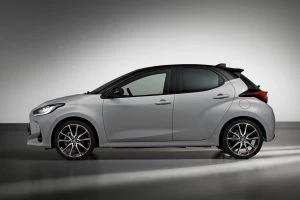
Toyota Yaris Hybrid Hatchback
Toyota Corolla Hybrid Hatchback 4.2 litres/100 km
Toyota Yaris Hatchback 4.9 litres/100 km
Mazda 2 Hatchback 5.3 litres/100 km
Toyota Corolla Hatchback 6.0 litres/100 km
Mazda 3 Hatchback 6.2 litres/100 km
MG3 Hatchback 6.7 litres/100 km
Hyundai i30 Hatchback 7.4 litres/100 km
Family & fleet (Sedans):
Toyota Camry Hybrid Sedan 4.7 litres/100 km
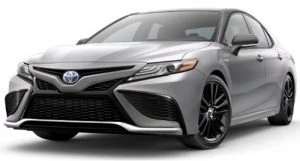
Toyota Camry Hybrid Sedan
Toyota Camry Sedan 6.8 litres/100 km
Small-Med SUV
Toyota RAV4 Hybrid 2WD 4.7 litres/100 km
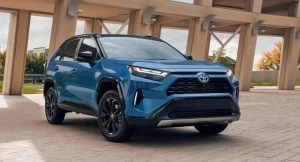
Toyota RAV4 Hybrid
Toyota RAV4 Hybrid AWD 4.8 litres/100 km
Mazda CX-3 2WD 6.3 litres/100 km
Mazda CX-30 2WD 6.5 litres/100 km
Toyota RAV4 2WD 6.5 litres/100 km
Mazda CX-5 2WD 6.9 litres/100 km
Toyota RAV4 AWD 7.3 litres/100 km
Mazda CX-5 AWD 7.4 litres/100 km
Mitsubishi Outlander 2WD 7.5 litres/100 km
Mitsubishi Outlander AWD 8.1 litres/100 km
Large SUV
Toyota Kluger Hybrid AWD 4.7 litres/100 km

Toyota Kluger Hybrid AWD
Hyundai Santa Fe AWD Diesel 6.1 litres/100 km
Kia Sorento AWD Diesel 6.1 litres/100 km
Toyota Prado 4WD Diesel 7.9 litres/100 km
Mazda CX-9 2WD 8.4 litres/100 km
Toyota Kluger 2WD 8.7 litres/100 km
Toyota Kluger AWD 8.9 litres/100 km
Toyota LandCruiser 300 Diesel 8.9 litres/100 km
Mazda CX-9 AWD 9 litres/100 km
Kia Sorento 2WD 9.7 litres/100 km
Hyundai Santa Fe 2WD 10.5 litres/100 km
Nissan Patrol Y62 14.4 litres/100 km
Ute
Nissan Navara STX 4WD Diesel 7.8 litres/100 km

Nissan Navara STX 4WD Diesel
Toyota HiLux SR5 4WD Diesel 8 litres/100 km
Ford Ranger XLT 4WD Diesel 8 litres/100 km
Isuzu D-Max XT 4WD Diesel 8 litres/100 km
Mazda BT-50 SP 4WD Diesel 8 litres/100 km
Mitsubishi Triton GLX+ 4WD Diesel 8.6 litres/100 km
Ford Ranger XLT 4WD Diesel 8.9 litres/100 km
LDV T60 Max 4WD 2.0L Diesel 9.2 litres/100 km
GWM Ute 4WD 2.0L Diesel 9.4 litres/100 km
Toyota HiLux Workmate 2WD 10.9 litres/100 km
Ram 1500 DS Limited 12.2 litres/100 km
Ram 1500 DT Express 12.2 litres/100 km
Chevrolet 1500 LTZ 12.8 litres/100 km
Van
Hyundai Staria Load van Diesel 7 litres/100 km
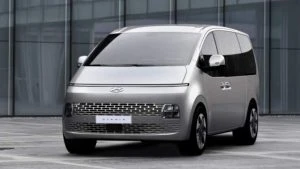
Hyundai Staria Load van Diesel
Ford Transit Custom van Diesel 7.3 litres/100 km
Toyota Hiace LWB van Diesel 8.2 litres/100 km
LDV G10 van Diesel 8.2 litres/100 km
LDV G10 van 11.1 litres/100 km
Toyota’s Hybrid vehicles, if they suit you needs, top their classes with fuel bills that were roughly half their nearest rivals. The Hybrid versions of the Toyota Yaris Hatch, the Toyota Corolla Hatch, the Toyota Camry Sedan, the Toyota RAV4 SUV, and the Toyota Kluger are the ones I’m talking about here.
Lightyear One – a Solar Powered EV

Lightyear One – a Solar Powered EV
In a country like Australia where the sun shines brightly for most of the year a car like the Lightyear One might be just the thing for getting around in. Sleek and comfortable, the Lightyear One is a solar-powered electric vehicle (EV) that has been designed and engineered in the Netherlands by Lightyear.
Having been recently tested in Italy, the Lightyear One completed 400 km on a single charge while driving at a constant speed of 130 km/h. According to Lightyear One’s manufacturer, regular driving will easily result in a range of 725 km (WLTP). If you’re like me and don’t know what WLTP means, then WLTP stands for Worldwide Harmonized Light-Duty Test Procedure. This mouthful is a new standard to measure fuel consumption, CO2 emissions, and range. The standard was introduced in 2017 and takes the measurements of test vehicles when driven in realistic driving situations to determine their fuel consumption, range, and emissions.
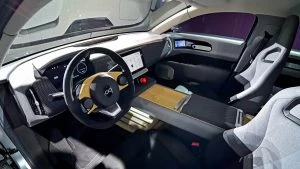
Lightyear One Interior
Because the Lightyear One is a solar-powered EV, its manufacturer also states that it would be possible to drive the car for months without needing to recharge. In Australia, where the sun shines most days of the year, a car like the Lightyear One would be perfect for this scenario. Take a good look at the car’s exterior and you’ll see the array of solar panels incorporated into the sleek exterior design. All of the panels facing skyward are made of solar panels and are ready for harvesting energy from the sun to charge the 60 kWh battery. 5 m2 of solar panels cover the Lightyear One’s roof, bonnet and tail and are capable of harnessing up to 12 km of range every hour. That means during a sunny 8-hour workday, a parked up Lightyear One could harvest 96 km of driving range – more than enough for most people’s work commutes. Even in cloudy conditions, its maker claims the Lightyear One that around 40 km of range can be harvested in that time. Obviously, you can also plug the car in for a quick recharge if you ever needed to.
Jump in the Lightyear One and drive on a full charge, and the Lightyear One’s 60 kWh battery pack provides a claimed 725 km of range, making it one of the most energy efficient EVs on the market. Efficiency of this standard is also achieved thanks to its construction consisting essentially of aluminium and carbon-fibre which gives it a weight of just 1315 kg. Also the car’s drag coefficient of just 0.20cd is sensational. As you can imagine, the aluminium and carbo-fibre underpinnings also drive the price of the car upward.
The Lightyear One is being manufactured in Finland, where its first deliveries will be made to Europe in mid-2022. The car’s price is around the AUD $238,000 mark. Just 946 of these cars will be built, however the company is already working on a more affordable solar-powered EV called the Lightyear Two which is expected to go on sale in 2024/25. It will have a much more affordable price, maybe even as low as AUD $50,000.
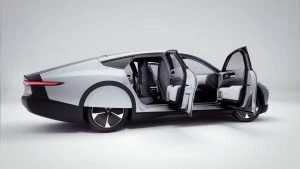
Lightyear One Sedan
In the Lightyear One there are 4 electric motors on board, one for each wheel. These provide the driving power. Together, they produce a combined 101 kW of power and 1200 Nm of torque. The car’s manufacturers say that the Lightyear One Sedan can seat 5 in comfort, and it has been designed especially for cruising and efficiency, and not for outright speed, thus claiming a 0-100 km/h sprint time of around 10 seconds.
I hope we see cars like this become available to people in Australia very soon. It also begs the question: Couldn’t the Holden name resurrect itself by Holden designers and engineers making a similar type of car in Australia for primarily Australians?